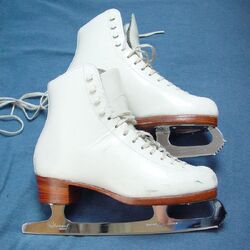
Figure skates
Figure skates are a type of Ice skate used by figure skaters. The skates consist of a boot and a blade that is attached with screws to the sole of the boot. Inexpensive sets for recreational skaters are available, but most figure skaters purchase boots and blades separately and have the blades mounted by a professional skate technician.
History[]
Ice skates have a history dating back thousands of years. Specific figure skates were created in response to the rise of figure skating's popularity in the 19th century, coinciding with the beginnings of formalized competitions such as the World Figure Skating Championships. The name "figure" skating arises from the compulsory portion of the competition, dropped in the 1990s, requiring skaters to trace out precise figures on the ice, including perfect figure 8 circles.
Boots[]
Figure skating boots are traditionally made by hand from many layers of Leather. The design of figure skating boots changed significantly during the 20th century. Old photographs of skaters such as Sonja Henie from the 1920s and 1930's show them wearing thin, supple boots reaching to mid-calf. Modern skating boots, on the other hand, are extremely rigid to support the foot and ankle in jumps, and are cut much lower -- just over ankle height -- to allow the foot to flex. Because the stiffness of the boots makes good fit essential, many skaters either order custom boots or have their boots "bumped out" over pressure points by a skate technician.
In recent years, boots made of synthetic materials with heat-moldable linings have become popular with many skaters because they combine strength with lighter weight than leather boots, and are easier to "break in". The latest development in boot technology is a boot that is hinged at the ankle to provide lateral support while allowing more flexibility. Boots used in ice dance are usually slightly lower in the back to allow for greater bend in the ankle. Some boots also come with a flexible elastic back.
The typical colors for boots are black for men and white or tan for women, although other colors are available.
Blades[]

Close-up of a figure skating blade, showing the toe picks, hollow grind on the bottom surface of the blade, and screw attachment to the boot.
Figure skates differ most visibly from hockey skates in having a set of large, jagged teeth called toe picks (also known as toe rakes) on the front of the blade. The toe picks are used primarily in jumping and footwork, and should not be used for stroking or figure skaters. Toe pick designs have become quite elaborate and sometimes include teeth on the sides of the blade.
The skate blades are typically made of tempered Steel, coated with a high-quality chrome. Lightweight alloy blades are becoming more popular with high-level skaters. Blades are about 3/16 inch () thick and may have a slightly tapered cross-section.
When viewed from the side, the blade of a figure skate is not flat, but curved slightly, forming an arc of a circle with a Radius of . The "sweet spot" of the blade is below the ball of the foot. This spot is usually located near the Stanchion of the blade, and is the part of the blade where all spins are spun on.
The blade is also hollow ground; a groove on the bottom of the blade creates two distinct edges, inside and outside. The inside edge of the blade is on the side closest to the skater; the outside edge of the blade is on the side farthest from the skater. In figure skating it is always desirable to skate on only one edge of the blade, never on both at the same time (which is referred to as a flat). The apparently effortless power and glide across the ice exhibited by elite figure skaters fundamentally derives from efficient use of the edges to generate speed.
Ice dancers' blades are about an inch shorter in the rear than those used by skaters in other disciplines, to accommodate the intricate footwork and close partnering in dance. They also possess a smaller pick near the bottom to allow for better edge-work and less focus on jumping.
Blade types[]
Various specialty blade types exist, including:
- Tapered figure skating blades have a design which causes them to be thicker at the front near the toepicks and thinner at the tail of the blade; therefore, the edges are not parallel.
- Side honed figure skating blades have a concave design which causes them to be thicker at the stanchions and the edge stripe and thinner in between. They are easily recognizable because they cause reflections to be inverted.
- Parabolic figure skating blades were first introduced by HD Sports in order to employ new scientific developments in the creation of figure skating blades. The middle section of parabolic blades is thinner than that of normal blades, while both ends are typically wider than those of regular blades. This translates into less steel and a lighter blade overall. Their design is meant to improve skaters' blade stability, footwork, and edges.
References[]
External links[]
| This page uses content from Wikipedia. The original material was at Figure skate. The list of authors can be seen in the page history. As with Figure Skating Wiki, the text of Wikipedia is available under the CC-by-SA License. |